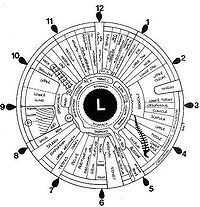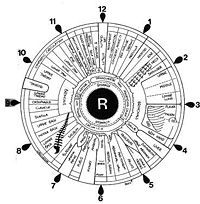From Abracadabra to Zombies | View All
iridology
I believed that the human body was some sort of remarkable collection of intelligent organs and systems that worked together almost magically to create a healthy unit. --Confessions of a Former Iridologist
 Iridology is the study of the iris
to diagnose disease. It is not part of the curriculum of any medical school
and its practitioners are not usually medical doctors. (Naturopaths
are not medical doctors.) According to
Wikipedia, iridology is not regulated or licensed by any governmental
agency in either Canada or the United States.
Iridology is the study of the iris
to diagnose disease. It is not part of the curriculum of any medical school
and its practitioners are not usually medical doctors. (Naturopaths
are not medical doctors.) According to
Wikipedia, iridology is not regulated or licensed by any governmental
agency in either Canada or the United States.
Iridology is based on the questionable assumption that every organ in the human body has a corresponding location within the iris and that one can determine whether an organ is healthy or diseased by examining the iris rather than the organ itself.
Medical doctors see the iris as the colored part of the eye that regulates the amount of light entering by a contractile opening in the center, the pupil. The lens brings the light rays to a focus, forming an image on the retina where the light falls on the rods and cones, causing them to stimulate the optic nerve and transmit visual impressions to the brain. Medical doctors and optometrists recognize that certain symptoms of nonocular disease can be detected by examining the eye. If a problem is suspected, these doctors then refer the patient to an appropriate specialist for further examination. However, recognizing symptoms of disease by looking in the eyes is not what iridology is about. In fact, when iridologists have been tested to see if they could distinguish healthy from sick people by looking at slides of their eyes, they have failed. In a study published in the Journal of the American Medical Association (1979, vol. 242, 1385-1387), three iridologists incorrectly identified nearly all of the study slides of the irises of 143 healthy and diseased people. “In fact, they often read the irises of the sickest people as being healthy and vice versa. They did not even agree with each other.” Similar results involving five Dutch iridologists were published in the British Medical Journal (1988, vol. 297, 1578-1581) (Lisa Niebergall, M.D.).
Iridology goes way beyond the claim that the eyes often provide signs of disease. Iridologists maintain that each organ has a counterpart in the eye and that you can determine the state of the organ's health by looking at a particular section of the eye. The markings and patterns in the iris are compared to an iris chart, which maps zones of the iris and links them to parts of the body. No scientific investigation led to these charts; instead, they are the work of intuition.


Ignatz von Péczely, a 19th-century Hungarian physician is usually credited with inventing iridology. He got the idea for this novel diagnostic tool when he saw a dark streak in the eyes of a man he was treating for a broken leg and it reminded him of a similar dark streak in the eyes of an owl whose leg he had broken years earlier. Von Péczely then went on to document similarities in eye markings and illnesses in his patients. (According to Wikipedia, von Péczely's nephew, August von Péczely, dismissed the story about the dark streaks as apocryphal. The Wikipedia article also notes: "Iridology is not supported by any published studies and is considered pseudoscience by most medical practitioners and eye care professionals." Even if the story is apocryphal, I like it because it illustrates the magical thinking of practitioners and patients.) Others completed the map of the eye. A typical map divides the eye into sections, using the image of a clock face as a base. So, for example, if you want to know the condition of a patient's thyroid gland, you need not touch the patient to feel for any enlargement of the gland. Nor do you need to do any tests of the gland itself. All you need to do is look in the iris of the right eye at about 2:30 and the iris of the left eye at about 9:30. Discolorations, flecks, streaks, etc. in those parts of the eyes are all you need concern yourself with, if it is the condition of the thyroid you wish to know. For problems with the vagina or penis, look at 5 o'clock in the right eye. And so on. An iridologist can do an examination with nothing more than an iridology map, a magnifying glass, a flashlight, and a vivid imagination.
If von Péczely's reasoning is typical, we can surmise that he and other iridologists deceived themselves by looking for and finding correlations between eye markings and illness (confirmation bias). They were working with vague notions of "markings" and "illness." Diseases may not have been precisely or accurately diagnosed in many cases. They were able to validate iridology by finding many correlations that in fact were not established as causal relationships by rigorously defined controlled studies. Some of their correlations may be accurate, but many are undoubtedly bogus, due to very broad interpretations of "markings" and "disease." They found patterns where in fact there are no patterns (apophenia). They misinterpreted data and gave extraordinary significance to confirmations, while ignoring or not seeking disconfirmations. Many of their confirmations may have been matters of subjective validation. We do not know how much the power of suggestion played in their patients' illnesses. Many diagnoses were probably wrong, but no objective tests were done to check out the validity of the diagnoses. Some diagnoses may have been correct but the iridologists may have been using other signs besides eye markings to make their diagnoses. Finally, much of the success of iridology is due to the same factors that account for the success of acupuncture, homeopathy, and other forms of so-called "alternative" medicine: placebo effects.
What is most peculiar about the iris is that each is unique and unchangeable, so much so that many claim that the iris is a better identifier of an individual than fingerprints.
See also acupuncture and reflexology.
further reading
websites
"Confessions of a Former Iridologist" by Joshua David Mather Sr.
Iridology by Stephen Barrett, M.D.
Iridology's Blind Side by George Nava True II
books and articles
Ernst, Edzard. 2000. Iridology: not useful and potentially harmful. Arch Ophthalmol. Aug;118(8):1141. 77 papers were reviewed. None of the studies examined found any benefit from iridology. "As iridology has the potential for causing personal and economic harm, patients and therapists should be discouraged from using it."
Raso, Jack. "Alternative" Healthcare: A Comprehensive Guide (Amherst, NY: Prometheus Books, 1994).


